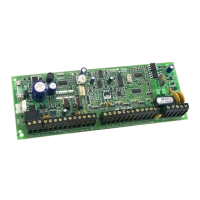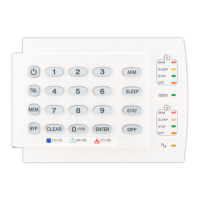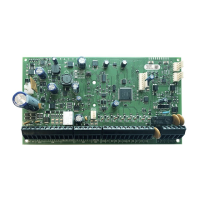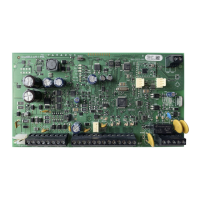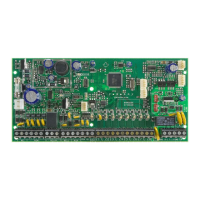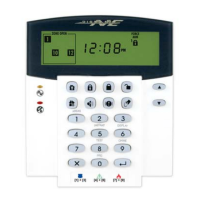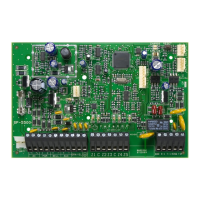18 Reference & Installation Manual
Figure 26: Reporting Options
6.2 Monitoring Station Telephone Number 1 (MSTN1)
Streamline - Section 04 and 05
D
Hex Programming - Addresses 016 to 023
The control panel will dial the programmed telephone number when reporting an event code to the monitoring station computer
(see Reporting Options on page 17). For example, if the alarm system is armed and a zone with a motion detector opens, the
control panel may dial the telephone number in order to send the programmed event code to the monitoring station computer.
There is no default telephone number and you can enter any number from 0 to 9 up to a maximum of 16 digits. If you would like
to enter any special keys or functions, refer to Table 5 below. If the telephone number contains less than 16 digits, press the
[
TBL]/[TRBL] key to indicate the end of the telephone number.
[
ENTER] + Installer code + [7] + [0] [4] + MSTN1 + [ENTER] or [TBL]/[TRBL] if number is less than 16 digits
6.3 Monitoring Station Telephone Number 2 (MSTN2)
Streamline - Section 06 and 07
D
Hex Programming - Addresses 024 to 031
The control panel can communicate with two monitoring station numbers. The control panel may at times dial the second number
depending on the selected Reporting Options (see Reporting Options on page 17). If the monitoring station does not have a
second number, you must enter the same number as the first. There is no default telephone number and you can enter any
number from 0 to 9 up to a maximum of 16 digits. If you would like to enter any special keys or functions refer to Table 5. If the
telephone number contains less than 16 digits, press the [
TBL]/[TRBL] key to indicate the end of the telephone number.
[
ENTER] + Installer code + [7] + [0] [6] + MSTN2+ [ENTER] or [TBL]/[TRBL] if number is less than 16 digits
Both monitoring station telephone numbers must be programmed in order for event reporting to function
properly.
Table 5: Telephone Number Special Instruction
Enter special instructions in the telephone numbers using these keys:
[0] = the number “0” [
BYP] = switch from pulse to tone while dialing
[
STAY] = *[MEM] = pause 4 seconds
[AWAY]/[FORCE] = # [TBL]/[TRBL] = end of telephone number
MSTN = Monitoring Station Telephone Number
The following set of timing diagrams represents the dialing sequence of each of the three reporting options.
Regular Reporting:
Split Reporting: All codes are sent to MSTN2 except when the system is in alarm, codes will be sent to MSTN1.
Double Reporting: All codes are sent to both monitoring station telephone numbers.
Once communication is established and the events have been uploaded, the control panel will begin dialing MSTN2.
System not in alarm:
System in alarm:
OR
AND
Dialing
Disconnected
Dialing
Disconnected
Dialing
Disconnected
Dialing
Disconnected
Dialing
Disconnected
Sequence ends and keypad
displays “communication failure”
trouble key [7].
Sequence ends and keypad
displays “communication failure”
trouble key [7].
Sequence ends and keypad
displays “communication failure”
trouble key [7].
Sequence ends and keypad
displays “communication failure”
trouble key [7].
Continues by dialing MSTN2
Sequence ends and keypad
displays “communication failure”
trouble key [7].

